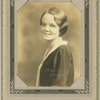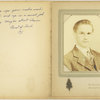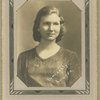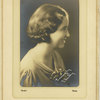Lovingley Shirley

A few days ago, my wife and I went to look for a dresser at a nearby shop that we had never been to. I will admit that shopping for furniture probably is not very high on the list of things I enjoy doing. But that is not the reason why it took me considerable time to actually enter the store once we had arrived. In the little room one had to walk through to get into the main showroom there were a couple of baskets filled with old postcards and photographs. In fact the whole store was selling more than just furniture. Of course, I had to leaf through the entire collection of postcards and photographs, to see whether there was something of interest. There was. (more)
Apart from the usual old snapshots, most of them not very interesting at all, there were various studio portraits, all of them in very fine shape inside their original cardboard covers. I assembled seven and went to ask how much I’d have to pay for them. Five dollars. For all of them. In the meantime, my wife had found a very nice mid-century dresser, and once I had added a huge binder filled with hundreds of negatives of some family from the 1940s (ten bucks), two very happy campers left the store. Who knew that shopping for furniture could be so much fun?
There were two reasons why I had picked those old studio portraits. First, I actually like the images. I have no idea who any of those people are, but these photographs are very nice. In addition, all of these photographs were produced - and packaged - very well. The scans will give you an idea of what the images look like, but unfortunately, they fall short of conveying the beauty of the prints, and the different cardboard frames and covers. They’re beautiful objects, produced with a lot of attention to detail. Many of the cardboard covers feature embossed flourishes. When you hold any one of these studio portraits you literally feel that at some stage they were clearly very important to someone.
This had me thinking. I have two young nieces, and every year, there are new school photographs. It is a little bit like comparing apples and oranges, but the quality of those modern school photographs doesn’t even remotely approach those of the studio portraits I bought. I even remember a photo that was slightly out of focus, and these new images tend to fade amazingly quickly. I know I’m going to sound quite a bit older than I am, but quality doesn’t seem to be the main focus of studio portraiture any longer. Instead, it seems the focus is on “cheap”. And cheap you get.
Add to that the fact that my two nieces have literally thousands of photos of themselves (I wrote about this a while ago), and you arrive at a very strange situation. My nieces have thousands of photographs of themselves, but as far as I can tell, not a single one of the few printed ones might survive the next decade. It will sound very old-fashioned again, but holding and looking at the old studio portraits that I bought is an experience that you don’t get from the cheap digital shots produced today.
As we’re moving more and more into the digital world, we are losing our sense of the photograph as an object. You might argue that, well, there will be digital devices that you will use. But that’s not quite the same, is it? In fact, if you think that the experience of looking at a photograph on an iPad, say, is the same as holding an actual photograph, especially an old studio portrait, then you might just have no idea what I’m talking about.
You might wonder why this matters or whether it matters at all. I’ve been trying to find out. I think what it comes down to for me is that I actually like the object aspect in photography. And it’s not just all about the object itself, it’s about the fact that photographic objects can be precious. We’re steadily losing that experience.
It would seem, however, that that’s not entirely true. Photographs have been selling for ever more money, and photobooks have become coveted objects. In fact, you might argue that I’ve got this all wrong. What’s really happening, you might argue, is that the photograph (or photobook) has become a more and more precious object even though digital photography is advancing steadily.
But this is not the kind of “precious” I am talking about. An expensive photograph by, say, Andreas Gursky, might be worth a lot of money, but as an object it’s pretty useless for most people. Those photographs are so big that they don’t even fit into normal people’s homes, and they’re also not affordable for anyone but museums or the superrich. Make no mistake, I love looking at those photographs, but as objects they are surreal for me.
Talking about photobooks, we have witnessed a somewhat similar trend. Photobooks also have become highly collectible, and we now have books about photobooks (the fact that a book might be featured in one of those usually increases its value considerably). But for many of those books, they are considered precious not necessarily because of their photography, but because they’re objects of financial speculation. Photobooks have entered the world of Leicas or Rolexes.
For example, I own a first edition copy of Alec Soth’s Sleeping By The Mississippi. It’s a great book. I love that book. But for a long time, I was worried about looking at it, given that it’s worth a lot of money. But what’s the point of owning a photobook if you don’t even want to look at it, since you want to avoid having it change from its mint condition into something that might be just very slightly less mint? A friend of mine told me I could simply sell the book and then buy the latest (third, I think) edition. That also feels wrong to me. I used to tell my friend that I’d do that if the cover of the third edition was as nice as the first-edition one. But the real reason why I’m not going to sell the first-edition book is because it was a gift from a friend of mine. Knowing that I now happily look at the book. The photographs make it a precious photobook; and the fact that a friend gave it to me make it a precious object.
Recently, we have also witnessed an explosion of self-publishing, where the focus is on the photography and not necessarily on whether or not the book might sell for a thousand dollars in a few years. I find this development extremely encouraging: In the world of the photobook, the object has become both a fetish (just like a Gursky print), and it has remained a precious object (precious here of course not in terms of monetary value). Contrast that with photographs themselves: As prints, they’re treasured when they’re produced for a gallery (or someone’s wall), but hardly anyone cares about prints outside of that context any longer.
Maybe studio prints or old snapshots that you buy at a flea market play the role of self-published photobooks. There are all kinds of explanations for the question why people love looking at those old photos so much. Maybe it’s really just because they’re objects, and looking at a photography while holding it is simply a different experience. I
Whatever it might be, it is old photographs and photobooks that teach us something about the role of the object in photography. It seems that some things simply can’t be replaced by their digital equivalents.
Or maybe I’m just really getting old.
 By
By 





